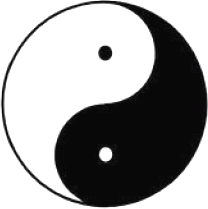Interlude
No “Tyranny of the OR” (Embrace the “Genius of the AND”)

You’ll notice throughout the rest of this book that we use the yin/yang symbol from Chinese dualistic philosophy. We’ve consciously selected this symbol to represent a key aspect of highly visionary companies: They do not oppress themselves with what we call the “Tyranny of the OR”—the rational view that cannot easily accept paradox, that cannot live with two seemingly contradictory forces or ideas at the same time. The “Tyranny of the OR” pushes people to believe that things must be either A OR B, but not both. It makes such proclamations as:
• “You can have change OR stability.”
• “You can be conservative OR bold.”
• “You can have low cost OR high quality.”
• “You can have creative autonomy OR consistency and control.”
• “You can invest for the future OR do well in the short-term.”
• “You can make progress by methodical planning OR by opportunistic groping.”
• “You can create wealth for your shareholders OR do good for the world.”
• “You can be idealistic (values-driven) OR pragmatic (profit-driven).”
Instead of being oppressed by the “Tyranny of the OR,” highly visionary companies liberate themselves with the “Genius of the AND”—the ability to embrace both extremes of a number of dimensions at the same time. Instead of choosing between A OR B, they figure out a way to have both A AND B.
As we move into the rich detail of the next eight chapters, you’ll encounter, as we did in our research, a series of these paradoxes—apparent contradictions in many of the visionary companies. For example, you will encounter:
| On the one hand: | Yet, on the other hand: | |
| purpose beyond profit | AND | pragmatic pursuit of profit |
| a relatively fixed core ideology | AND | vigorous change and movement |
| conservatism around the core | AND | bold, committing, risky moves |
| clear vision and sense of direction | AND | opportunistic groping and experimentation |
| Big Hairy Audacious Goals | AND | incremental evolutionary progress |
| selection of managers steeped in the core | AND | selection of managers that induce change |
| ideological control | AND | operational autonomy |
| extremely tight culture (almost cult-like) | AND | ability to change, move, and adapt |
| investment for the long-term | AND | demands for short-term performance |
| philosophical, visionary, futuristic | AND | superb daily execution, “nuts and bolts” |
| organization aligned with a core ideology | AND | organization adapted to its environment. |
We’re not talking about mere balance here. “Balance” implies going to the midpoint, fifty-fifty, half and half. A visionary company doesn’t seek balance between short-term and long-term, for example. It seeks to do very well in the short-term and very well in the long-term. A visionary company doesn’t simply balance between idealism and profitability; it seeks to be highly idealistic and highly profitable. A visionary company doesn’t simply balance between preserving a tightly held core ideology and stimulating vigorous change and movement; it does both to an extreme. In short, a highly visionary company doesn’t want to blend yin and yang into a gray, indistinguishable circle that is neither highly yin nor highly yang; it aims to be distinctly yin and distinctly yang—both at the same time, all the time.
Irrational? Perhaps. Rare? Yes. Difficult? Absolutely. But as F. Scott Fitzgerald pointed out, “The test of a first-rate intelligence is the ability to hold two opposed ideas in the mind at the same time, and still retain the ability to function.”1 This is exactly what the visionary companies are able to do.
